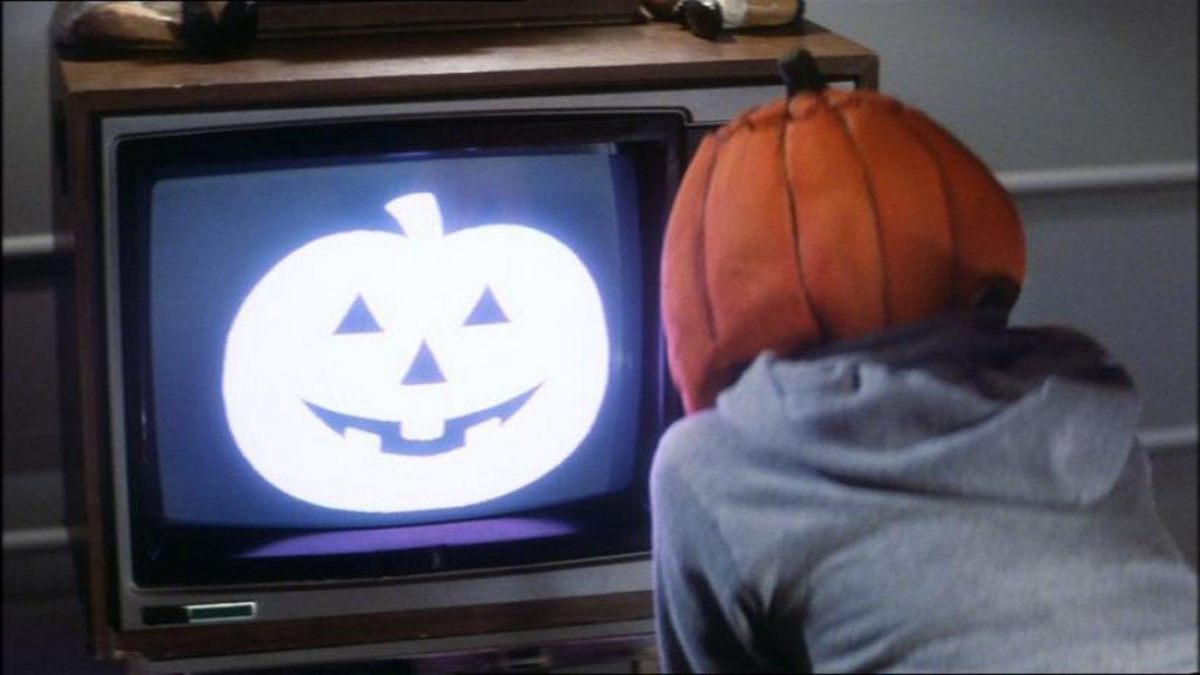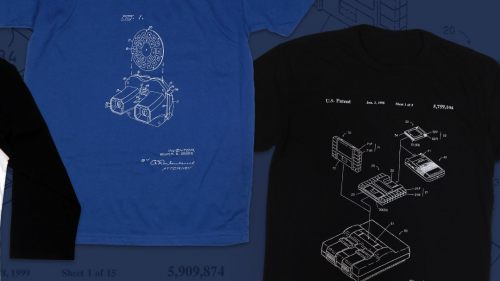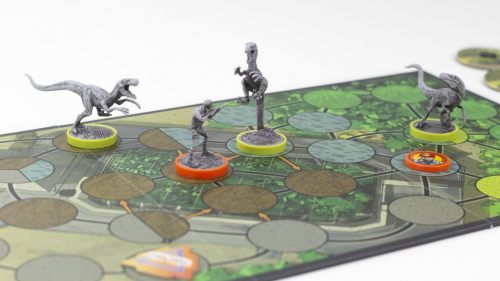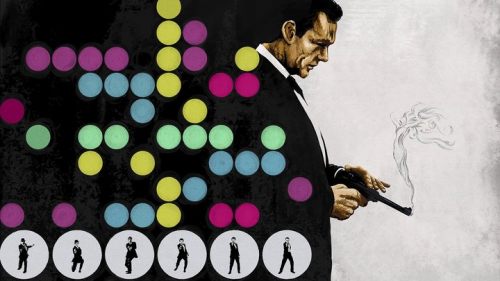EXCLUSIVE: And Now, An Interview With HALLOWEEN III Composer Alan Howarth
Disclosure: Mondo and Birth.Movies.Death. are both owned by the Alamo Drafthouse.
Don't forget to buy your copy of our incredible Halloween magazine here!
From Halloween to They Live, Escape From New York to Prince of Darkness, John Carpenter’s scores have become synonymous with an entire generation of genre filmmaking, a cornerstone that has influenced and inspired countless disciples and imitators. Alan Howarth was not only one of his closest musical collaborators but one of the artists in his own right who picked up Carpenter’s torch and carried it forward, burnishing the filmmaker’s legacy as he explored his own creative instincts. After decades as a sound designer and composer, working not only with Carpenter but Steven Spielberg, Robert Zemeckis and Francis Ford Coppola, he has still only just begun to receive the recognition he deserves for his contributions to everything from Big Trouble in Little China to Raiders of The Lost Ark. But the upcoming release of a new Mondo box set featuring remastered scores from the first five Halloween films offers fans a new opportunity to explore his contributions both to this iconic franchise, and to filmmaking in general.
Birth.Movies.Death. recently spoke with Howarth via telephone about the music he worked with Carpenter to create for the Halloween franchise, and the process that led him to score parts 4 and 5 as a solo artist. While talking about the techniques and technology used to enhance and transform the original film’s iconic cues, he revealed details about the remastering process - and philosophy - used to find the right sound for these new releases. Finally, he reflected on which of these collaborations and acts of pure creation he loves most, or hopes listeners will take the time to explore now that they’ve been reissued on LP in beautiful new presentation and packaging (you can pre-order your copy here).

You are co-credited with John on Halloween II and III. Talk about how you two shared responsibilities, and then what you wanted to carry on - or change - when time came to do 4, 5 and 6.
My first film score with John was Escape From New York. We had a great time on that and we created some great music, and near the end of the scoring session, John said, “my next movie is going to be The Thing, but they want to do a sequel to Halloween, so you’re going to do Halloween.” It was like a class assignment. He basically said, “I’m going to be too busy - you take care of it.” So on Halloween II, I inherited John’s original score from Halloween, which was already iconic, and some say one of the greatest horror scores of all time. I got a transfer of that score on analog multi-track and transferred that to another tape, and I then overdubbed on top of John’s performance my textures and sweeteners. We wanted to use what we already had; it was already part of Halloween, so I took that and gave it a much darker feel, more of a gothic kind of thing. That’s really the difference between Halloween and Halloween II, the addition of new sound textures, and then there were a couple of cues that weren’t related to [the original].
But then we came to Halloween III, and John had really handed it off to Tommy Wallace to make the movie, but John still enjoyed doing the score. He mentioned to me several times that doing the score for his movies is like being on vacation; he can turn off the phone and isolate himself with just another person - in this case, me - and spend several weeks just working on the music. He’s been a musician since he was a kid, and his father was a professor of music and he’s been around it and was somewhat groomed to be a musician if he’d wanted to be. Music was always a secondary track for him. So I remember sitting down for Halloween III and just kind of getting started. We played the latest Tangerine Dream music - they always had the best synthesizer sounds and the coolest stuff of the day. And he looked at me and said, “Alan, this is going to be really easy - all we’ve got to do is rip ourselves off,” which was his way of saying everything we did on Escape From New York, let’s pick up where we left off and make new music for this movie. So the first cue we did for Halloween III was that chase - now called “Chariots of Pumpkins” - so I dialed up a sequence on my analog gear that is that now-famous opening scene. And John liked it because it had its own thing. It had a little something like Halloween - but it wasn’t Halloween.
The idea with Halloween III was to start making movies that took place on Halloween, but now Michael Myers was now dead - we killed him in the last movie. The score was very successful, but the movie got mixed reviews. At the end of it, the owners of the Halloween franchise, when the fans went, “where’s Michael Myers?”, they had a serious discussion and John and Debra Hill stepped away from the franchise, which then led into Halloween 4, 5 and 6. Mustapha Akkad approached me and said “do you want to do the music for Halloween 4?” and because John’s my buddy, I asked him what he thought. He said, “man, do whatever you want - I don’t talk to those people anymore.” So I took on the mantle of Halloween 4, 5 and 6, still utilizing the John Carpenter themes because the Halloween theme goes with Michael Myers. There’s a series of musical cues that Halloween described, and the producers said, “give me more of that.” So the recycling of John’s themes and putting them where they were was the underpinning or outline, and then I kind of went and did my own thing on Halloween 4 and really brought in influences of music that I liked, which is prog rock, English flavor of Pink Floyd, Genesis, more Tangerine Dream and more synthesizer stuff. And at the same time, that was the first introduction of digital samplers, so this is the first time the sounds in the score included digital samples of real recordings of instruments as opposed to only analog synthesizer stuff. That was among the first scores that were a hybrid of analog and digital.
I had a great time, and I did my thing; I think that was my favorite of the Halloween sequel scores that I did because it was my first, it was my baby, and I really enjoy that one. We then moved on to Halloween 5 and 6 and each director had their input to what they wanted the Halloween score to be like. In the case of Halloween 5, he really wanted to go back to Halloween and feature a piano, so that score really features a lot of piano, because I now had digital stuff and pianos on samplers, and I did a lot of stuff where parts of the score would [feature] two or three pianos playing at the same time - it would be more than one piano could have played. And it’s its own movie. When we get to Halloween 6, that’s another path because Dimension Films got involved, and they had their own input. There was the Producer’s Cut, the “original” version, and then another recut and another add-on thing and they really wanted to pump it up. So on Halloween 6 I went ahead and put electric guitars and drums and sort of made it a rock version of Halloween. So that’s the arc of the Halloween scores from my viewpoint.

Given your pedigree as a sound technician, how particular are you about the mastering or remastering of these scores?
The technical paths continued to increase. Halloween II was analog synthesizers and a sequencer and no real digital stuff recorded through a 24-track machine, and because there were no computers involved, you really had to play everything. You couldn’t just put it in a computer and quantize it and loop it and make it go - you had to play. So that was the ground floor to build this stuff. But on Halloween 4, we had samplers, and I had a sequencer on a Macintosh Plus or whatever it was with a whopping one megabyte of RAM, and floppy disks - there weren’t even hard drives. But the technology grew, and that helped with the source, how nice you could make it. And then emerging under that was MIDI, so by the time we got to 4, I had the ability to play one physical keyboard and trigger nine synthesizers at the same time. The textures are thicker and have a lot more variety than the analog synthesizers.
As far as the technical part, it was all still done on analog 24-track tape, so it went through a recorder that had videotape as the driver and synchronizer, and we watched the picture and improvised against it. None of this was ever really written down or scored for an orchestra; it was always intended for us to perform. The other thing that happened around Christine and heading into Halloween 4 and Big Trouble in Little China, was I began to record the entire effects onto the tape recorder. In the early days of analog recording, you would record each instrument at its maximum level because you were trying to beat the signal to noise [ratio] and stuff like that. But now the stuff was getting pretty good, so I would record at the level that it was supposed to be at. By the time we got to Halloween 4, the monitor section was pretty much straight across so if you put it at zero, the mix would already be there. This made it a lot easier to reproduce what I had and keep track of what was going on, and I would also print the instruments with the reverbs and echoes on them. Printing to tape was no longer a matter of keeping track of this and that, so I began to sort of “freeze” as I went, and really commit to the sound rather than trying to keep all of these variables under my fingertips.

Do you have to do anything different for contemporary audiences? Spencer Hickman at Mondo observed that you’re really making these for fans, not the creators, and the listening apparatus is more sophisticated than it was back then so you have to possibly present it differently now than before.
As far as the sound texture, they want it to be authentic. They don’t want me to change the sound, so it sounds constant. But remember, I was originally doing these for LPs and there was too much music, so they had to be cut down. Then we got to CDs and I did expanded versions because we had a lot of time and we made double-CD packages with 90 minutes of music - every cue uncut and every possible note of music from the movie. And now we’re going back to LPs and I have to re-editorialize, and I think that editorial is different than what I did then; now we think about the audience and the journey and the listenability of playing 22 minutes worth of music in a linear fashion. So that part of the editorial I definitely address, and then we got the new digital mastering tools that address various regions [of sound] and flatten out the sound which didn’t exist at the time. I definitely use those as part of my toolkit now, and that definitely makes it more finished, I guess is the word. It does keep up with current audio today - it gives it that extra edge.
Looking at your body of work, is there a compositional hallmark that you have found, something structural or tonal that maybe even in retrospect you’re like, “that’s in everything I do?”
Two flavors to that. Musically, I had the privilege of sitting in a room with John Carpenter for eight years, watching the master make music for his own movie. So I graduated from the school of John Carpenter and how he does it is how I do it - and he did it right. So the idea of the quarter-note pulse or when John started doing his music, it was so simple that if you were to intellectualize it, you’d be like, “really? A hold note for like two minutes? Are you serious?” But it worked for his movies. It created tension. So all of that stuff was in place and part of the “how do you do it” and so I incorporate that. Then the other part is the palette was made from ARP sequencers and synthesizers, and also I really brought to the party the Prophet 5, a sequencer. So there are Prophet 5 sounds that are my signature sounds that I still use today; there’s a Prophet 5 brass sound and a Prophet 5 string, and as soon as I fire up those sounds, they put me back to that spot. Those guys are still there; in fact, I just finished an independent film called Hoax, and the director, Matt Allen, actually wanted me to use the original analog synthesizers, as opposed to the digital software versions of it. So I went out and found an original Prophet 5 in pristine condition and used it a lot on his score, and he was super pleased. I’ve got to say, there’s a subtle but listenable difference between the original analog instruments and the digital models. It’s a little warmer, a little fatter, and more work, because you’re back to tape recording. But when I fire up the Prophet 5, I hear the sounds of Halloween, Escape From New York, and Christine coming out of that machine.

At the risk of getting a “they’re all my children and I don’t want to pick one” answer, do you have a score that is your favorite or of which you’re most proud?
The whole Carpenter catalog I did with him, they’re all my babies. But the most successful score we did was for Big Trouble in Little China, and the reason for that was a combination of things. First, it was the first one that had all of the MIDI stuff going, and then also the content of the movie had us do a lot of different kinds of music - rock and roll, adventure, there was scary stuff, there was an Asian element. So as a symphony, Big Trouble in Little China is I think the greatest thing we did together. But in the Halloween world, Halloween 4 is my personal favorite because that was the first time I got to sort of stretch out and do my own thing. And then Halloween III is really good; there was an article written in Rolling Stone of the 35 Best Horror Film Scores of all time, and Halloween was Number One, and Number Two was Halloween III. Number 14 on the list was Christine. Those are the ones that I think for someone who doesn’t know this work, or wants to hear from me where my gold stars live, those are them.
This article is part of B.M.D. Guide To: Halloween



